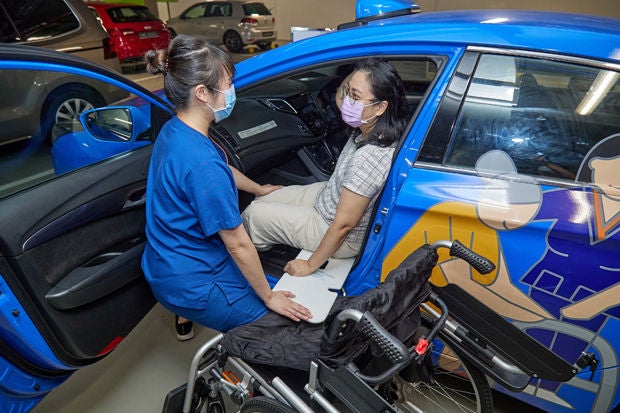
Ms Samantha Ong shows how a patient with an amputation (role-played by SGH Communications Department’s Ms Brenda Ng) can be helped into a taxi from a wheelchair using a transfer board.
Losing a limb can be debilitating, but occupational therapists help patients learn how to live independently and return to their daily activities.
Having a foot or even a toe cut off is a traumatic and life-changing experience.
The patient may experience phantom limb sensation — feeling pain or itching in a foot that is no longer there — and other more practical, everyday concerns like how to maintain his balance, walk and change his clothes.
Occupational therapists can help these patients return to everyday life, be it taking care of themselves with or without the help of a caregiver, enjoying their hobbies, or returning to work, said Ms Samantha Ong, Occupational Therapist, Occupational Therapy Department, Singapore General Hospital (SGH). “Activities that used to be done with ease become arduous. The home or work environment may now pose barriers to daily tasks. Having an occupational therapist to journey alongside the patient during crucial moments greatly eases the transition to living with an amputation,” said Ms Ong.
Patients eager to walk again after losing a few toes may inadvertently put pressure on the amputation wound that has yet to heal. Should the wound not heal and recover well, there is a risk of infection and gangrene, which may require another amputation.
“A patient who had two toes taken out must remember to step down on the unaffected foot and on the heel (of the foot with the amputation) each time he gets out of bed to sit on a chair or walk to the toilet,” said Ms Ong.
 Those with amputations just below, at or above the knee are likely to face greater challenges such as pain, altered or phantom sensations, altered balance and altered self-image. Patients with phantom sensations need to learn desensitisation strategies early in their recovery to manage the phenomenon. To adapt to the changes in their balance, they have to strengthen their unaffected limbs and the trunk.
Those with amputations just below, at or above the knee are likely to face greater challenges such as pain, altered or phantom sensations, altered balance and altered self-image. Patients with phantom sensations need to learn desensitisation strategies early in their recovery to manage the phenomenon. To adapt to the changes in their balance, they have to strengthen their unaffected limbs and the trunk.
“If they have difficulty keeping their balance, how can they put on their trousers or stand and prepare their meals safely?” she said.
Occupational therapists can help identify patients’ needs, prescribe assistive devices or mobility aids, and train them in their use for greater independence.
Immediately after amputation, patients often need a walking aid or a wheelchair to move around. If prostheses are not suitable, patients can consider a personal mobility aid like a motorised scooter.
Patients or their families may not understand the different features of wheelchairs and their importance. A heavy bag hung at the back of a wheelchair without anti-tippers raises the risk of the chair falling backwards when it is going over small humps or steps. Anti-tippers are small wheels attached to the rear to provide added support and balance for those with lower limb amputations.
The home environment often needs changes to make moving around easier and safer for amputees. Before the amputee returns home, the occupational therapist will assess and recommend changes to the home, such as installation of ramps and grab rails, and the use of non-slip mats in toilets.
Psychological help is also often needed to overcome issues of anxiety, altered self-image, and sense of helplessness. Occupational therapists can refer them to a psychologist or medical social worker, or encourage them to participate in peer groups like the SGH Amputee Support Group.
“We believe that a person’s ability to perform daily activities promotes health. The more they do things themselves, the easier it is for them to overcome feelings of anxiety or helplessness,” said Ms Ong.
| Why diabetes can lead to amputations High blood sugar levels damage nerves, so people living with diabetes may not feel heat, cold or pain in their toes, feet, fingers and hands. They are likely to also have poor blood circulation. When they get a cut, especially in their feet, people with diabetes may not realise they have an injury, which can lead to infection. If that injury is not treated and it progresses, the patient runs the risk of an amputation of the affected part. |













 Get it on Google Play
Get it on Google Play